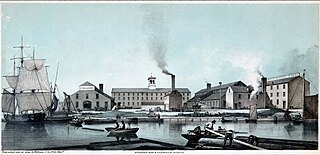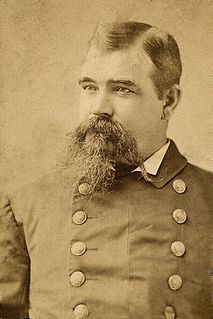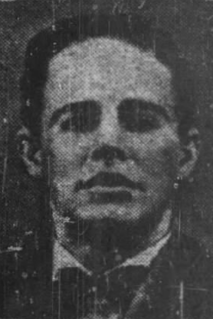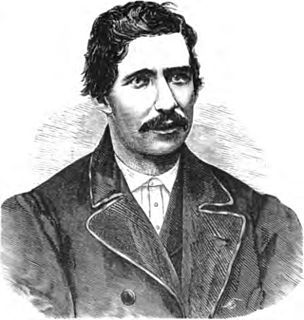Related Research Articles

The Hook Gang was a street gang, and later river pirates, active in New York City in the 1860s and 1870s. The gang was prominent in the Fourth Ward and Corlear's Hook districts immediately after the American Civil War, until their breakup by the New York City Police Department in 1876.
William J. "Wild Bill" Lovett was an Irish American gangster in early 20th century New York.
Suds Merrick was a New York river pirate and member of the Hook Gang during the 1870s. Merrick, along with Tommy Shay, James Coffee and Terry Le Strange, operated in the New York waterfront and involved in burglary and pickpocketing as well as raiding the nearby vessels anchored in the Hudson River. Merrick would co-lead the gang with Le Strange during the early 1870s until the arrest of Sam McCracken, Tommy Bonner, and Johnny Gallagher after they had looted the canal boat Thomas H. Brick and sent to Auburn State Prison in 1874. Following this incident, Merrick turned control of the Hookers to Bum Mahoney although he would remain with the gang in a limited capacity until his death in 1884.

Sadie Farrell was an alleged semi-folklorish American criminal, gang leader and river pirate known under the pseudonym Sadie the Goat. However, there exists doubt as to her historical existence.
Albert "Al" Rooney (1892-?) was an American gang leader and founder of the Fourteenth Street Gang. One of the independent gangs allied with Monk Eastman, most of them former members of the Humpty Jackson gang, Rooney led the group from the mid-to late 1900s (decade) until the New York City Police Department launched a four-year citywide campaign to break up the countless street gangs operating in the city between 1910 and 1914. Rooney was one of the first gang leaders to be imprisoned and, with his conviction of second degree murder in 1911, is considered one of the last generation gang captains of the "Gangs of New York" period.

James "Wild Jimmy" Haggerty was an American criminal and well-known underworld mob figure in Philadelphia and later in New York City during the mid-to late 19th century. Jimmy Haggerty was the leader of the Schuylkill Rangers, a predominantly Irish-American street gang, which terrorized the South Philadelphia waterfront, specifically its local wharves and coal yards, for over 25 years.
Richard Joseph "Peg Leg" Lonergan was an American underworld figure and labor racketeer. He was a high-ranking member and the final leader of the White Hand Gang. He succeeded Bill Lovett after his murder in 1923 and, under his leadership, led a two-year campaign against Frankie Yale over the New York waterfront until he and five of his lieutenants were killed in South Brooklyn during a Christmas Day celebration at the Adonis Social Club in 1925.
Captain Isaiah Rynders was an American businessman, sportsman, underworld figure and political organizer for Tammany Hall. Founder of the Empire Club, a powerful political organization in New York during the mid-19th century, his "sluggers" committed voter intimidation and election fraud on behalf of Tammany Hall throughout the 1840s and 1850s before Tammany became an exclusively Irish-dominated institution.
The Bowe Brothers were a criminal family in New York City during the early-to-mid-19th century. The gang was headed by Martin Bowe, owner of the Catherine Slip sailors' home Glass House, and included Jack, Jim and Bill Bowe. All were well-known shooters, cutters and thieves in New York's Fourth Ward and often led waterfront thugs in raids on dockyards and ships anchored in the East River. The brothers were also fences and disposed of money obtained by other waterfront gangs.
Francis J. Banfield was an American soldier, law enforcement officer, police sergeant and founding member of the New York City Police Department "Steamboat Squad". Born in England, he emigrated to the United States as a child. He worked as a painter in his youth and later served in the Mexican-American War. He lived in California for a time before returning the New York to join the police force in June 1857.

Anthony J. Allaire was an American firefighter, drillmaster, and military and law enforcement officer. A longtime police inspector for the New York City Police Department, he was responsible for the breakup of numerous street gangs, most notably the Slaughter House Gang and the Dutch Mob, as well as the capture of murderer Daniel McFarland in 1869.

George W. Gastlin born George Washington Gastlin was an American law enforcement officer and police captain, with the New York City Police Department, who founded the "Steamboat Squad" and served as its commander, during the 1870s and 80s.

Thomas F. "Tanner" Smith was an American criminal and gang leader in New York City during the early 20th century. He was the founder and leader of the Marginals, or "Irish Paddy Gang", which was active in Greenwich Village and along the Hudson River waterfront from around the turn of the 20th century until his murder in 1919. He was closely associated with Owney Madden and the Gophers; he and Madden briefly ran the Winona Club together until the New York City Police Department closed the clubhouse around 1910.

Patrick Conway, commonly known by his alias Patsy or Patsy Conroy, was an American burglar and river pirate. He was the founder and leader of the Patsy Conroy Gang, a gang of river pirates active on the New York waterfront in the old Fourth Ward and Corlears' Hook districts during the post-American Civil War era.

The Patsey Conroy Gang or Patsy Conroys were a group of river pirates active along the New York City waterfront of the old Fourth Ward during the post-American Civil War era. For nearly twenty years the Patsy Conroys dominated the area of Corlears' Hook and were one of the last major waterfront gangs to remain in the district prior to the formation of the George Gastlin's Steamboat Squad of New York City Police Department. The Patsey Conroy Gang abruptly disappeared when their leaders Patsy Conroy, Larry Griffin and Denny Brady were imprisoned in 1874.
Thomas Hadden was American saloon keeper, criminal and underworld figure in New York City's infamous Fourth Ward during the mid-to late 19th century. He was the owner of a Cherry Street dive bar, a popular underworld hangout located next to Dan Kerrigan's place, and co-led the Dead Rabbits with Kit Burns. For over 25 years, his Water Street boarding house was one of the most notorious "crimp houses" on the New York waterfront as thousands of sailors were shanghaied, robbed or murdered. Hadden, and contemporaries such as Bill Slocum or John Allen, exercised considerable political influence in the city and were generally able to receive protection from city officials throughout their criminal careers.

Michael "Pugsey" Hurley, also known by the aliases Pugsey Reilly or Hanley, was an English-born American burglar, river pirate and underworld figure in New York City during the mid-to late 19th century. An old time thief from the old Seventh Ward, he was also a well-known waterfront thug whose criminal career lasted over two decades. He especially gained notoriety as a member of the Patsy Conroy Gang and was a principal figure in many of their most infamous crimes.

James "Old Jimmy" Hope was a 19th-century American burglar, bank robber and underworld figure in Philadelphia and later New York City. He was considered one of the most successful and sought after bank burglars in the United States during his lifetime as well as a skilled escape artist for his repeated breakouts from Auburn State Prison in New York.
Michael Mahoney, better known as Wreck Donovan or simply The Wreck, was a nineteenth-century American sneak thief, river pirate and underworld figure in New York City. He was a well-known criminal for hire on the New York waterfront during the post-American Civil War era and later became a member of Patsy Conroy Gang.

A river pirate is a pirate who operates along a river. The term has been used to describe many different kinds of pirate groups who carry out riverine attacks in Asia, Africa, Europe, North America, and South America. They are usually prosecuted under national, not international law.
References
- 1 2 Sutton, Charles; James B. Mix and Samuel A. Mackeever, ed. The New York Tombs: Its Secrets and Its Mysteries. Being a History of Noted Criminals, with Narratives of Their Crimes. San Francisco: A. Roman & Co., 1874. (pg. 481)
- 1 2 Asbury, Herbert. The Gangs of New York: An Informal History of the New York Underworld. New York: Alfred A. Knopf, 1928. (pg. 77) ISBN 1-56025-275-8